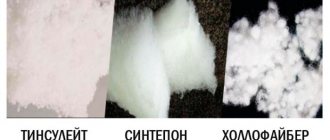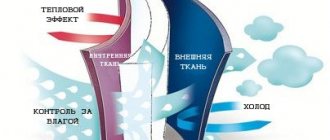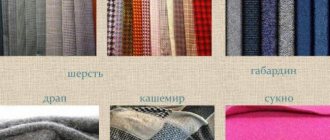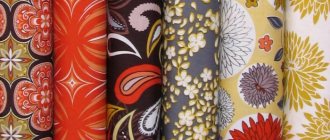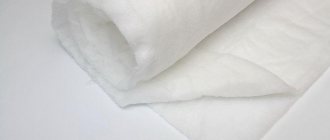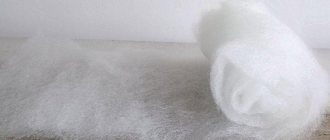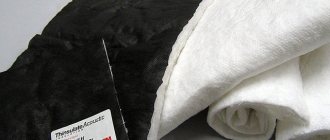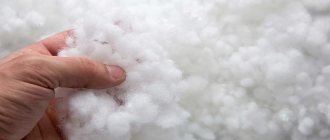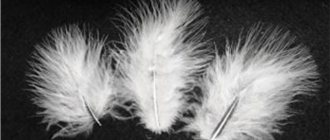The advantage of synthetic insulation is that they are hypoallergenic, they do not harbor microorganisms (mites, etc.), and clothes with various “fibers” (“fiber” is translated as “fiber”) inside hold their shape better and do not deform from washing, Keeps you warm and doesn't let cold air in. So, let's deal with insulation without going into highly scientific jungle. First rule
When you see a new, unfamiliar name, don’t rush!
The manufacturer, trying to capture the attention of the consumer, comes up with its own (trade) names for insulation materials. Consider the label on the jacket or overalls. Don’t be surprised if you see the inscription: “insulation – polyester 100%”. And where, you know, is that “fiberskin” or “polyfiber”? Almost any synthetic insulation consists of polyester fibers. Thus, on the label you will read what the material for the insulation is made of, and more detailed instructions or a sales consultant should tell you what the name of the insulation itself is, what technology it is made of, and what this technology provides. Products from reputable companies have a special booklet where all the materials are described in detail and their qualities are indicated. Second rule
80% of childhood colds are not to blame for the immune system, but for parents who do not know how to dress their child.
For example, a child who often suffers from colds should never be re-wrapped, and it is absolutely forbidden to wear thick hats and tie tight scarves. Not a single seller will be able to explain to you whether your child will freeze in just such clothes. All new generation synthetic fillers work on the same principle: they retain heat well. Look for (ask) an indicator of the permissible temperature (up to -10° or up to -40°). Third rule
Remember that it is not the insulation that heats, but the air in its cavities. The lighter the fibers, the more cavities inside, the lower the temperature at which these clothes can be used. The best thermal insulator is air. The label on a real down jacket should say “down”. This means that the fluff inside is eider, swan or goose. 100% “down” is quite rare. Most often, feathers are added to it and written “feather”. If the label says “cotton,” then this is not a down jacket, but just a lined jacket. The inscription “wool” indicates that there is wool batting inside this jacket, and the word “polyester” or “waltern” refers to padding polyester or its modern varieties.
Introduction
The whole world and our lives in it change daily - climate, place and living conditions, social status, social circle, work and leisure, income, plans, mood, fashion and much, much more... What remains unchanged is man’s eternal desire for warmth and comfort when in any weather and under different circumstances.
Therefore, when updating their wardrobe with the approach of cold weather, many people prefer down clothes (in common parlance - down jackets) - coats and jackets, vests and overalls - warm, soft and voluminous, creating the effect of security and comfort. Today, there are many different tips and recommendations on how to choose a down jacket, checking a lot of designations and taking into account a large number of details. Most of them are based on the argument that the most important thing in a “correct” down jacket is the down. In fact, EVERYTHING is important in a down jacket. Unless, of course, it is a high-quality functional down jacket made by real professionals.
The concept of high-quality and functional down clothing and its manufacturers
Currently, there are more than 20 American, Canadian, Swedish, Norwegian, Finnish, German, French and Italian companies recognized throughout the world as leading manufacturers of down clothing. The basis of the authority and prestige of these companies is many years of experience and an integrated approach to creating clothing for difficult weather and climatic conditions, winter sports and extreme types of human activity. Most of the leading manufacturers of down clothing, independently or jointly with other specialized companies, conduct research and development in the field of innovative high-tech materials and technologies, own numerous patents, have advanced developed quality control systems at all stages of product production and conceptual approaches to environmental protection. Their products are thoroughly tested before release, all the pros and cons are analyzed.
Thus, a well-made down jacket has the following characteristics:
- Ergonomic cut that does not restrict movement . The comfortable design of the jacket will allow you to easily raise your hand to the handrail in transport, adjust the thermal protection by adding or removing the necessary layer under your outerwear, without turning into a shock or, conversely, into a tightly stretched barrel :)
- Light jacket weight. If the manufacturer uses high-quality filler correctly, the jacket will weigh very little. Even if you are not that active on foot, you will definitely appreciate this characteristic, which other types of winter clothing do not have in principle.
- Excellent thermal insulation properties. A lightweight down jacket, depending on the density of the filler, can protect a person down to Antarctic extremely low temperatures.
- Wind and moisture resistant material. As a rule, a high-quality product has the necessary wind/moisture protection. Manufacturers are constantly improving production technologies for their materials for jackets. A technological combination of completely synthetic or a mixture of synthetic and natural fibers is used. The high-quality material for the jacket is tear-resistant and provides excellent protection from wind and wet snow. In some cases, the material may have breathable properties.
- Ergonomics and details. In the cold winter, it is not always convenient to dig through your pockets for a long time wearing gloves in search of keys or a mobile phone. A good jacket has a well-thought-out arrangement of pockets with clasps, a windproof zipper placket, a hood that is really comfortable to use, with the ability to adjust the head, drawstrings for the sleeves or internal knitted cuffs, as well as drawstrings in the right places to adjust the jacket to fit and creating additional thermal insulation.
Therefore, when choosing your jacket, you should focus on whether a product from a particular manufacturer meets the criteria you need. By analyzing some of the technologies used by winter jacket manufacturers and understanding how they will work in the products themselves, you can more confidently make the right choice when purchasing winter clothing, which is usually purchased for more than one season.
What is the best insulation for a jacket in winter?
In order not to fall into the trap of a salesperson who convinces you that warm clothes are the best, you should know what types of fillings there are for winter jackets. You also need to know their quality characteristics.
What is the warmest winter jacket filling on the market? Every seller will praise the insulation that is used to sew his products. Fans of natural materials will argue that there is nothing better than down or sheepskin. But the price of such goods is almost astronomical.
The developers who created synthetic fibers managed to significantly reduce the cost of insulation. Fillers made from them (sintepon, padding polyester, holofiber, Thinsulate) are gradually replacing sheepskin and down from the market. They easily succeed due to many advantages: low cost for manufacturers and buyers, durability of warm clothing, practicality.
Manufacturers focus on the differences in insulation not only in price, but also in properties and quality. Therefore, it is difficult for users to decide the question: what is the warmest filling for jackets in winter.
To solve this problem, you need to carefully study the label on the product and know the characteristics of the fillers. Any of the fillers used are made from polyester fibers. A consultant should provide information about the features, production technology of a particular insulation, and its advantages. Well-known global companies offer a special booklet with information about the materials used and their qualities.
It is difficult to unequivocally answer the question of whether your child will freeze in a particular jacket. The fillings of winter jackets perform their main function, represented by the ability to retain heat. Look for a label on the clothing indicating the permissible temperature. It is the density of insulation for a winter jacket that manufacturers count on a specific ambient temperature. Winter jackets have different permissible temperatures: from -10 to -40.
It is important to know that it is not the jacket filling that warms in winter, but the air inside its cavities. Lighter fibers have more cavities inside. Accordingly, the temperature at which this clothing option can be worn will be lower. Air is considered the best thermal insulator.
If the down jacket is natural, there is an inscription “down” on the product label. With such a label, you can be sure that down is used as insulation. It can be swan, eider, or goose. When adding feathers to down, “feather” is indicated on the label.
When using wool batting, the label will indicate "wool". Synthetic winterizer and any other synthetic material is marked as “polyester”, “waltern”. If it says “cotton”, then this option is not suitable for the winter; it is a lined jacket.
The choice of insulation materials is varied. It is important to remember that heat is retained by air layers, and not by the insulation material itself. Therefore, it is important that winter clothing has a top layer in the form of a membrane. This fabric is a thin laminated film with micropores. It does not allow water to pass through, protects from wind and is a “breathable” fabric.
Therefore, if you need a winter jacket for a child, you decide for yourself which insulation is best in your case. For urban winter, adults and children should choose warm clothes with membrane fabric and insulation with a suitable temperature indicator.
MAIN TYPES OF INSULATIONS
Sintepon is divided into two types: old (dense) and new (hollow). Both are made from polyester fibers. Bonding of fibers to each other is carried out thermally. Previously, synthetic winterizer was laid in parallel layers. Because of this, it had very low performance in terms of heat conservation and moisture conductivity. Nowadays, dense padding polyester (thick, adhesive) is used only in cheap products. In the new padding polyester, the fibers are not glued together, but seem to be held together with the help of silicone needles. This insulation is more durable and does not lose its shape. But still, synthetic winterizer continues to yield to modern inventions. After exposure to sweat and washing, it loses up to half its thickness. And it is not suitable for cold winters - maximum, for temperatures down to -10°. Care: wash at 30°C, using only soft powders that do not contain bleaching agents; do not soak or bleach.
Thinsulate is considered one of the best insulation materials at the moment; its heat-saving properties are equal to down. Consisting of very fine fibers that retain heat excellently, overalls and jackets made with Thinsulate are light, thin and warm. It does not deform when washed, it can warm you in severe frosts, provided that the person moves, preferably actively. Thinsulate clothing is made for athletes, oil workers, and climbers. Thinsulate clothing is usually not cheap. Permissible temperature range for Thinsulate: up to -30°. Care: machine wash with spin at 40°.
Holofiber, fiberskin, fibertek, polyfiber, isosoft... Synthetic insulation made from fibers shaped like balls, springs, etc. Balls, spirals or springs do not communicate with each other and contain cavities, so the product holds its shape well. For a small price you buy a good overall that can withstand temperatures down to -25°. Care: machine wash with spin at 40°.
History of down jackets
In general, this or that clothing filled with down for thermal insulation has been used for quite a long time. These are the winter suits of some peoples of Siberia, and some clothes with down filling among the Scandinavians. However, in its modern form, the down jacket appeared in the USA. Its creator was Eddie Bauer, who later founded the company of the same name, which has successfully produced warm and comfortable clothing to this day. According to Eddie himself, the idea of such clothing was suggested to him by his uncle, who was born in Siberia. In 1936, Eddie Bauer designed and created a jacket that was quite technologically advanced and new at that time. Based on its silhouette, it could be described as a “bomber,” i.e. e. it was a short jacket with knitted cuffs and a short collar. Down was used as filler. The item was quilted diagonally so that the filling would not bunch up. The very first versions of this model had a cotton top. For its time, this was a revolutionary product; the jacket was very light, warm and comfortable. Here are archival photos of the very first Eddie Bauer down jacket models.
Over the years, down-filled jackets have become popular and loved by a wide variety of consumers. Among them were hunters and tourists who had to stay outside for a long time in winter, as well as ordinary people who wanted convenience, lightness and comfort from winter clothing, because... at that time, things for the winter were quite heavy. Over time, production technologies developed, new models appeared, a variety of companies began to produce similar clothes, and the down jacket became firmly established in the everyday wardrobe of a modern person. By the way, a jacket similar to the one with which this story once began can be bought today. This model is called Eddie Bauer -Skyliner .
Understanding the Question
You should initially keep in mind that high-quality warm clothing is developed for specific conditions of use, i.e. assumes social, weather, natural conditions of its use, the degree of protection from cold, wind, water, methods of taking into account the natural characteristics of the human body, etc. Therefore, a real high-quality down jacket is a complex of specific materials, technologies, designs and design solutions that provide the necessary properties of the product. If we represent this as a formula, we get:
Purpose => materials + technology + construction + design => consumer properties
Therefore, when planning to purchase a down jacket, you must have an accurate idea in what conditions you are going to wear it.
Let's consider the constituent elements - the “building blocks” of our formula:
Natural filling materials for down jackets
Let's try to understand the traditional question - what is it made of and how does it work?
The very idea of a down jacket is a jacket with good thermal insulation, which, thanks to its design, materials and filling, is relatively lightweight and does not restrict movement. It all works quite clearly too. The filler, due to its properties, creates an air layer that helps preserve the wearer’s heat.
The best material for filling is the down of waterfowl. In other matters, fluff can be very different in its qualities and properties. When making a down jacket, the filling is placed in special quilted bags, which can be visible from the front side of the down jacket or not visible at all, depending on the design.
Waterfowl down (eider, goose, duck) – due to its lightness, elasticity, breathability and high heat-shielding properties, it is considered the best of all known insulation materials for clothing.
Eiderdown is a unique down of wild ducks that nest mainly on Arctic coasts.
A wild product that cannot be obtained under artificial conditions. It is separated naturally from adult females during the period of molting and egg laying.
The collection and most of the processing of this fluff is done manually, using unique “dry” cleaning technologies.
The fluffs have a specific structure and firmly adhere to each other. Therefore, during operation of the product, the eider down insulation does not form lumps, does not spread, maintaining a constant shape and thickness. Very light and elastic, has the lowest thermal conductivity, high hygroscopicity, breathability and durability. Mined in small quantities, it is used to make very expensive, high-quality blankets and exclusive clothing.
Goose down is the down from the breasts of very young geese.
It is obtained on an industrial scale mainly from birds raised in captivity under special conditions. It lends itself perfectly to mechanized processing, slightly inferior in properties to eider down. The most common natural insulation material used in a variety of clothing and household items.
Duck down is the down from the breasts of very young ducks. It is collected, processed and used in the same way as goose down, but has a finer and more delicate structure.
Control of fluff production
A significant part of goose and duck down used in warm clothing is a by-product of the food industry. At the same time, down with the highest consumer properties should be collected manually during the natural molting period of birds. In order to make a profit, some geese and duck breeders use cruel methods to collect down from live birds several times during the raising process. To eliminate such phenomena and for the purpose of comprehensive control of the quality of raw materials, the practice of constant monitoring of the conditions of development and maintenance of birds, and methods of collecting down, has become widespread among leading manufacturers of down products. Patagonia specialists were the first to introduce a system of humane treatment of down production in 2007.
Control of processing, properties and quality of fluff
Down and feather production technologies, properties and quality of raw materials and finished products, requirements for hygiene, cleanliness and safety for humans are regulated by relevant state and international standards. Down and feather raw materials and products undergo testing and quality certification in accordance with these standards in the regional divisions of the International Down and Feather Testing Laboratory (IDFL - The International Down and Feather Testing Laboratory).
In Europe, the standards of the European Down and Feather Association (EDFA-European Down and Feather Association) apply, and testing and certification are carried out by specialized laboratories.
The norms of the EN 12934 standard establish the rules for designating the composition of insulation after final processing. Class I includes only new insulation made from down and waterfowl feathers of first use. The percentage of down and feathers in the insulation should be indicated on the product label using a fraction - for example, “85/15”. It is believed that high-quality insulation should contain at least 80% fluff. The use of the term “pure” for the type of down - for example, “pure goose down” (pure goose down) - is permitted if the admixture of other types of down in the insulation does not exceed 10%.
The standards of the EN 12935 standard establish requirements for the cleanliness and hygienic quality of insulation. Products with insulation that has undergone the necessary processing, testing and meets the requirements of the standard are marked with the Daunasan® and Downafresh® logos.
Experts say that the service life of products with such insulation, if the recommendations for use and care are fully followed, can be up to 20 years.
The PAS 1008 standard establishes safety criteria for people with dust allergies. Products with insulation that has undergone the necessary processing, testing and meets the requirements of the standard are marked with the NOMITE® logos.
The main parameter characterizing the thermal insulation properties of natural insulation is the Fill Power indicator, expressed in cubic inches per ounce (in?/oz). The Fill Power for each batch of down is determined by the results of a special test: a 28.4 gram (1 ounce) portion of down is kept for 3-5 days in a graduated cylinder with a diameter of 241 mm with a control scale under a load of 68.3 grams at certain temperatures and humidity levels. The volume occupied by a portion of fluff in the cylinder at the end of the test is the Fill Power value of the fluff of this batch. Fill Power test scores show the quality of down: up to 400 – low, 400/500 – average, 500/750 – excellent, over 750 – exclusive. Currently, innovative high-tech technologies make it possible to obtain unique fluff with a Fill Power rating of 900.
The physical meaning of this parameter is the volume occupied by a unit mass of fluff of a certain quality and density. The practical significance of this parameter is the ability to obtain various combinations of thermal insulation qualities, volume, weight and price of the product, depending on the purpose and required consumer properties.
This video shows how the Fill Power test is performed
However, in any case, one should keep in mind the fact that people's sensitivity to air temperatures can be completely different. And it is impossible to say with 100% certainty that in this jacket with exactly such technologies and filler density, a particular person will be absolutely comfortable in certain weather.
Yes, almost all serious manufacturers of warm winter clothing provide thermal insulation ratings for their products. They combine their products into collections according to their properties or classify products in some other way for ease of selection. However, all these classifications are advisory in nature, so it is worth studying the issue more carefully.
In addition, the Fill Power parameter refers specifically to the quality of the filler itself, regardless of the temperature rating of the down jacket itself, so it is not worth making the thermal insulation of a product directly dependent on the FP parameter (which is what some stores do). For example, a clearly lighter jacket designed for slight frost can have exactly the same Fill Power rating as a down jacket for extreme temperatures. There is absolutely no mistake here.
To determine the optimal temperature regime for a jacket, there is a parameter - the degree of insulation (Fill Down). However, this indicator is not always indicated. Therefore, a thorough study of the product of interest would be an advisable solution.
Types of cotton fillings for jackets
Due to its hygroscopicity and low thermal conductivity, cotton, unlike cotton, has become a filling material for jackets. Before the advent of synthetic materials, cotton insulation was the only material used in the production of winter clothing. It has been proven that the best thermal insulator is air, so the tubular structure of cotton fiber allows it to perfectly retain heat in severe frosts.
Quilted
Quilted is an environmentally friendly material that retains heat well and does not contain allergenic components. This material is used to make fillings for children's jackets; it is also used to make quilted bedspreads from Ivanovo. The quilting keeps the material from bunching into lumps, however, you need to wash the products in the machine carefully, using the “Delicate” or “Hand” wash mode without spinning. It is best to dry clean jackets with cotton filling.
Mixed
Mixed insulation consists of cotton and additional components of natural or artificial origin. The most famous filler is batting, which consists of cotton wadding, wool and viscose. It may even include sewing waste. Find out about rayon fabric, which is a viscose substitute, here.
Quilted batting has become widespread, when the fibers are sewn in parallel onto a gauze lining. This process gives the material durability and wear resistance.
Technologies in the production of down jackets
Technology primarily concerns fabrics. The fabric for a good down jacket is primarily required to be waterproof. The fact is that down filling, even with minimal water ingress, begins to instantly lose its properties and, moreover, begins to deteriorate very quickly. For this reason, special attention is paid to the tightness and gluing of seams.
The North Face has its own proprietary FuseForm technology - these are seamless models, models with anatomically calculated shapes, providing an elegant silhouette with maximum freedom of movement + reduced product weight and easy packability due to the absence of seams or special methods for their formation. True, at the moment this applies more to light jackets than to winter clothes. However, the technology is quite interesting.
The most commonly used in the production of winter jackets with filling are modern fabrics with a membrane. Such fabrics are resistant to moisture and wind, at the same time they allow the evaporation of the human body to pass through them, preventing sweating. The most well-known membrane at the moment is Gore-tex. Manufacturers may call their membranes differently, but their operating principles are similar.
For example, the Swedish company Fjallraven calls its membranes hydratic.
And the American company The North Face has several types of membranes, united under the name HyVent
Good manufacturers pay no less attention to fabric processing. Thus, the Canadian company Canada Goose has its patented DWR (Durable Water Repellent) coating, which effectively prevents the penetration of moisture.
Attention is also paid to the fabric’s resistance to tearing and mechanical damage. For this, various types of reinforced threads and rip-stop fabrics are used. If you pay attention to the rip-stop fabric, it has a characteristic texture of reinforced “cells”. In case of damage, the gap will not extend beyond one cell.
Types of insulation for winter jackets. What types of fillers are there?
In the production of jackets and down jackets, various types of fillers are used. They are divided into 2 broad categories, which include additional varieties. The main categories are the following fibers:
- natural;
- synthetic (artificial).
Nowadays, synthetic filler for winter jackets is almost as good in quality and properties as natural filler. Their advantage can be safely called the low cost of raw materials. Therefore, now everyone can buy warm and inexpensive winter clothes.
Let's take a closer look at the frequently encountered types of fillers used for sewing winter clothes.
Pooh
This material is natural. To determine its quality, a calculation of the ratio of the following components is used: fluff, feather. On a good down jacket, the label should have the following indicators:
- 60/40.
- 80/20.
The first indicator is the amount of fluff, and the second is the amount of feathers. 100% down is basically not used. For the production of children's clothing, goose down is most often used. Down is still considered the warmest insulation for a winter jacket.
Pooh has earned the championship thanks to a combination of the following characteristics:
- high heat-saving properties;
- ease;
- long service life;
- insignificant transport volume.
The quality characteristics of down are determined by its structure. It consists of individual fluffs that can repel one another when straightened and enter one another after squeezing.
But down also has its drawbacks. This raw material acts as an allergen. It also provides a suitable breeding ground for mites. Given these features, fluff must undergo antibacterial treatment.
Another disadvantage is the ability to absorb moisture and difficulty in washing. Therefore, new models of children's winter clothing have appeared on the markets, in which the down is placed inside a special cover between the lining and the outer fabric. This cover can be removed before washing.
For washing you should use special liquid detergents. The recommended water temperature is 40 degrees. Rinsing should be thorough. For quick drying, you will need a good spin with a centrifuge.
Wool, sheepskin
This filler is capable of retaining heat down to -25 degrees. It is durable and wear-resistant. But there are significant disadvantages: heavy weight, the material absorbs moisture well. This type of insulation is more often used in the production of envelope overalls and transformers.
The best wool is considered to be the wool of New Zealand Merino sheep. Its advantage is that it does not absorb the smell of sweat. Due to the ability to deform after washing, it is recommended to clean sheepskin items in dry cleaners. There are excellent models with a detachable lining.
Primaloft
PrimaLoft is made from fine polyester fibers. The production of insulation is carried out by Albany International (America). The insulation fibers are as thin as possible, soft, and have a hollow structure. Having low weight, the material has excellent thermal insulation properties.
Thanks to a special production technology, the fibers form a dense surface tension. It prevents the penetration of moisture through the insulation layer, retains the wind, but does not interfere with the removal of vapors.
This material was developed for the production of gloves. In these products, the most important was considered to be the ability of the material to compress and retain heat when wet.
Thermolite
This insulation is developed on the basis of polyester. It was patented by INVISTA. The fiber structure is hollow, which provides high thermal insulation even in a humid environment. The material perfectly conducts moisture into the outer layers of warm clothing. At the same time, it itself does not absorb moisture.
Thinsulate
The diameter of the fibers of this insulation is no less than 10 microns (10 times thinner than the thickness of a human hair). This material is able to retain more air inside, having a smaller volume than other fillers.
Excellent ventilation is also considered an important advantage of the material. It does not absorb moisture, so it provides excellent insulation in wet conditions.
Sintepon
A well-known non-woven synthetic fiber with a three-dimensional structure. The thickness of the material is uniform throughout the entire canvas. Sintepon gives uniform slight shrinkage. It is widely used when sewing warm clothes, as a form-building material.
The production of padding polyester is carried out in 3 ways:
- adhesive;
- needle-punched;
- thermal.
It is recommended to wash products made with padding polyester at 30 degrees. It is worth using soft powders that do not contain bleaching reagents. The material cannot be bleached or soaked.
Holofiber
This filler was obtained by adding other materials to the padding polyester. Holofiber is insulation made from padding polyester with a high silicone content. Its fibers are twisted and multidirectional. It is also called holofan, fibertek, thermofiber. This material is widely used in the production of children's clothing. Its consumer qualities are as high as possible.
The advantages of the filler are:
- high thermal protection;
- low density;
- light weight;
- high degree of recoverability.
The material practically does not absorb moisture. It can be washed by machine. Permissible temperature is 40 degrees.
Isosoft
The specified synthetic filler is made of fibers made in the shape of a ball. The balls have cavities; the fibers do not communicate with each other. Therefore, the clothes keep their shape perfectly. The advantages are also:
- high heat retention coefficient;
- plastic;
- breathability;
- softness;
- small volume;
- hypoallergenic.
Artificial fillers
Along with down, artificial fillers are also worth briefly mentioning. Although formally jackets with such fillings cannot be classified as down jackets, nevertheless, among them there are many comfortable and technologically advanced models. In addition, some fillers can not only be as good as down in a number of indicators, but even surpass it.
Primaloft. This is a very thin fiber insulation. Its advantage is the fact that it is not as afraid of moisture as down. At the same time, Primaloft is only slightly inferior in weight to down. Such insulation continues to retain heat even if moisture does penetrate into the bag with the filler.
There are several types of Primaloft, including Primaloft Eco, which has exactly the same qualities but is made from up to 50% recycled materials.
Termoball. This is a joint development of The North Face and Primaloft. In fact, such a filler is no different in properties from natural fluff. Unlike the vast majority of artificial insulation, Termoball can be compressed into lumps like fluff and have the same elastic qualities as in the Fill Power test of natural filler. At the same time, Termoball retains all the advantages inherent in synthetic insulation. It withstands moisture well, does not deteriorate or rot.
The company claims that the future lies with such synthetic insulation, since such a filler does not require such careful gluing and processing of seams as is required for down. However, at the moment, due to the relatively high price, Termoball has not yet found such widespread use.
What is printed cotton (cotton)
Pure cotton fabric (cotton) is a white fabric. To obtain decorative textile fabrics, it is subjected to various dyeing methods. Printed cotton fabrics are most widespread. To obtain a pattern on cotton fabric, the following methods are used:
- hand printing;
- mechanical printing;
- airbrush spraying;
- screen photo printing;
- automatic multicolor print.
Hand printing for the manufacture of piece goods, which means a complex and time-consuming process. To obtain rolls of cotton fabric with a printed pattern, other 4 methods are used. Before you find out which insulation for winter clothes is better, you need to understand that printed fabrics made from cotton fiber are beautiful, durable, resistant to repeated washing and do not contain allergenic components. Printed cotton is used to make children's clothing. Find out about the use of diagonal fabric in everyday life here.
Winter jacket styles
We all have different rhythms of life, different conditions, different physical activity and, accordingly, different requirements for winter jackets.
All winter jackets with down or synthetic insulation can be divided into several types, which are found in the product descriptions.
parka
Long jacket with a hood. It usually has a length to mid-thigh or lower. Equipped with special drawstrings to adjust a voluminous item to your figure, as well as to create additional thermal insulation. The parka often has a fur trim on the hood, which creates additional protection from the wind when the hood is on, or the hood acts as a fur collar when it is folded back.
Fjallraven Barrents Parka
Down coat
This is an elongated version of the women's parka with length to the knee and below. In principle, most of what was said above about parkas is also typical for a down coat. But as a rule, this type of clothing has a fitted silhouette and this item looks more elegant.
Marmot Chelsea Down Coat
Jacket
This is a thigh length winter jacket. This can be a jacket with or without a hood (alternatively, the hood can be removable).
Marmot Mountain Down Jacket
Down bomber
Sometimes this is called a very short, waist-length down jacket with knitted cuffs and a belt. This option often comes without a hood, although there are options with a hood. Perhaps this type of jacket does not protect against the cold as well as a parka, but in certain conditions it may be preferable (for example, if a person spends a lot of time driving).
Bomber jacket from Canada Goose. This model uses a removable hood with fur trim.
Down Vest
This is, of course, not a jacket, but nevertheless, a vest with down or synthetic filling is a popular type of clothing. It can be worn as an intermediate layer under a light jacket or as independent clothing in the off-season. A down vest is also a good choice for people who spend a lot of time driving.
The North Face Nuptse Vest
To summarize the description of the styles, it should be borne in mind that any item in the above styles can be
- Slim. Close fit. Typical for designer fashion items that emphasize the figure or women's clothing.
- Regular. Medium classic fit
- Relaxed. Relaxed spacious seating. Characteristic for sports and travel items that do not restrict movement at all.
Design
Looking at models and collections of jackets, coats, parkas, vests, overalls and other things from recognized manufacturers, you can always find both products of a classic and traditional design (so to speak - “down jacket style”), as well as very elegant, bright and spectacular things. Perhaps products made in a traditional style are not so fashionable (primarily this can be attributed to women’s models), but the purpose of their manufacture is to protect from cold, snow and wind, to preserve your health and good mood for a long time.
Cabelas Trans Alaska Parka. A utilitarian down jacket for maximum heat retention in low temperatures. The loose cut (relaxed fit) does not restrict movement and provides additional thermal insulation.
Moncler Edward Jacket. Urban fashion down jacket. Slim fit, cropped silhouette, high sleeve opening. The emphasis is on external elegance and fashionable cut. However, it cannot be said that this down jacket is of poor quality. It’s just that the emphasis in this product is on cut and fit, and not on the purely utilitarian properties of the jacket.
Leading companies develop their models with the expectation that their practicality and functionality will delight you for many years, without losing consumer qualities or becoming outdated.
Thus, to buy a down jacket, parka, coat or vest (warm clothing with natural or artificial insulation) you need:
- Have a clear idea of what exactly you need and in what conditions you are going to wear it;
- Choose a reliable seller of such products;
- Based on information from the manufacturer and seller, choose a worthy product that suits your requirements.
We remind you once again that it is better to buy a down jacket from a recognized manufacturer and enjoy it for many years than to receive disappointment and financial losses.
Analogs
There are insulation materials that are similar to natural cotton, but are superior to it in many respects. But synthetic components have a number of serious disadvantages. This material will tell you what canvas fabric looks like.
The following materials are used in the production of warm clothing:
- natural fluff;
- camel's wool;
- padding polyester;
- holofiber;
- isosoft;
- Thinsulate.
Eider bird down, made from natural fillers, is a strong heat insulator. It is used to make clothes for the crews of polar stations and extreme climbers. Insulation materials based on natural down can cause allergic reactions and are expensive.
Camel or sheep wool retains heat well, but can cause allergies. Blankets made of camel wool, like clothes made with it, are heavy; the material is not used in the production of clothes for small children. This link will tell you about children's bedding with fitted sheets.
The popular padding polyester is practical and restores shape. The material accumulates static electricity and deteriorates with prolonged wear.
Holofiber has low thermal conductivity, which brings its quality closer to down. Does not absorb foreign odors and is not electrified.
Isosoft is an innovative insulation based on hollow synthetic fiber. The material is light and harmless, therefore it is used when sewing children's jackets and overalls. Complies with all European quality standards.
Thinsulate is one of the new generation of insulation materials. The characteristics are similar to artificial swan down, but exceeds it in terms of heat retention. The material is durable, does not fall off when worn and washed, does not absorb odors and does not cause allergies.
About Chinese down jackets
There are many negative reviews about down jackets made by various Chinese companies. Let's state the problem clearly:
- in China there is an association of down and feathers with their own requirements and standards;
- We do not know the quality criteria for products of this kind adopted in China for the domestic market and for export;
- We do not know how strictly the products of Chinese manufacturers are subjected to quality control and compliance.
At least, it was not possible to find such information when preparing this material.
It is possible that in China there are companies that produce down products of a decent level of technology and really high quality, but... We do not have reliable information about such manufacturers, knowledge and sufficient experience in working with Chinese goods to distinguish their products from poor examples of consumer goods, and or even fakes. When choosing something with the expectation of long-term use, it is better not to take risks, but to choose a proven quality product.
Yes, the “Dark Horse” may turn out to be a prize horse, but there is a high probability that it will also be an outsider nag.
On Chinese sites, an item may visually look quite attractive, but in fact the description may not contain any information about the filler, density, etc. without which it is difficult to make the right choice of a quality item.
For example, a jacket that looks like a Canada Goose Chilliwack Bomber hardly has anything in common with its “Canadian source of inspiration.” The description is also more than succinct. Although in the pictures everything is more or less decent.
Often, having purchased a nice thing based on pictures, an unlucky buyer is severely disappointed with the quality of the product, and the appearance of the received product may only vaguely resemble the image in the advertising photo in the product card. Perhaps the magic mantra about “cheap prices” has an effect on people, but it is unlikely that an arbitrarily low price is justified during long correspondence with unscrupulous sellers, opening disputes and other “delights” that greatly fray the nerves of the buyer.
There is also a deliberate misleading of the buyer. The description can be either completely primitive, or completely unrealistic indicators are stated. For example, here is the first down jacket from the Middle Kingdom that came across.
In general, judging by the description on the website, this manufacturer itself sells down as a raw material and could well describe the product more truthfully.
I think there’s no point in trying to be witty about the brand name, let’s take a little more detailed look. The declared filling density is as much as ...800FP goose down, which suggests very high quality down, which is quite rarely used only in special series for extremely low temperatures!
As we can see, this is more than an ordinary product that can hardly really claim to be of high quality
I think it’s worth repeating and saying that such examples do not necessarily characterize the Chinese light industry completely. However, there is no reliable data on the value of Chinese goods. A wise decision would be not to give in to the tempting persuasion of the sellers and the suspiciously low price, and leave the sad experience to someone else.
How not to buy a fake
There is now a lot of information on how to distinguish a fake from an original when choosing a product in an online store. You can compare manufacturer logos, fabric textures, labels, etc. for quite a long time, but one way or another, all such recommendations come down to a simple and rational idea - buy down jackets from trusted stores (sellers).
In online stores that offer high-quality products, you can always get the necessary information about the desired model. You can inspect the products of leading manufacturers with detailed descriptions on the manufacturer’s website.
As for purchases from private sellers on Ebay, you should carefully look at the description and photographs of the product, the seller’s rating and reviews. At the same time, it is necessary to keep in mind the possibility of an unscrupulous dealer posting photographs of someone else’s goods. In any case, a Chinese seller who regularly sells products from well-known manufacturers with a constant 50% discount can hardly be a guarantor of a quality product.
In principle, so much has already been written about this that it’s probably not worth repeating what has been said once again. If you need to choose a quality item, you need to purchase it where they sell quality items. You can buy a jacket with more modest characteristics and a more budget-friendly price, but it will be of quite high quality. So I repeat once again, you should not stoop to buying a fake, such a product will not bring you joy.

